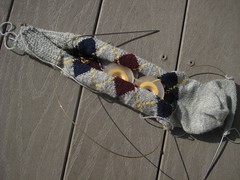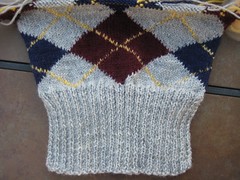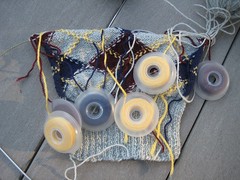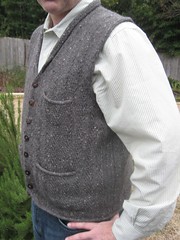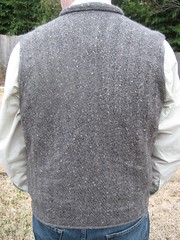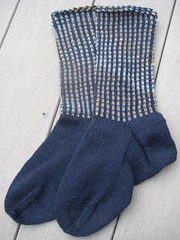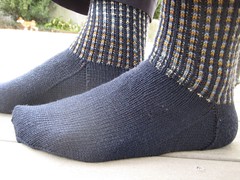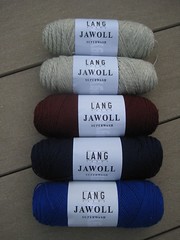I made some progress on the Argyle Socks while at the in-laws' earlier this week. The days were filled with many activities (musical theater, family reunions, museum exhibitions), so I didn't get as much done as I would have liked. And, I ran into problems.
I've found that the bobbins don't always naturally drape on the side that you want them to. Especially the ones at the opposite end of the needle from where I'm working. Several times, the bobbins have fallen on the wrong side and caused quite a bit of confusion. I managed to figure it out when it happens -- every time but once. And oh, that one time.
I got to the end of a row and found that the bobbin had flopped over to the other side and I had just blithely knit past it. So I had a strange navy loop that ran from the front of the sock, around the selvage edge, and then to the back. I had done this about ten rows back. You would think a mistake would be easy to see, but with all the bobbins bouncing around, it must not have registered. I had two choices -- tink back much of a day's work, or pull the needle out and rip back.
Naturally, I thought the former would be best, but after the first row it was driving me nuts. So, I went with plan B. I got all spread out on the kitchen table (the knitting I mean, not me) pulled the needle out, and then just methodically frogged, color by color, untwisting at the color changes as I went. It was very unnerving, but it worked. I even managed to get all 70 stitches back on the needles in the right combination. I sweated bullets, but I had the whole thing done in half an hour.
As you can see from these pictures, the construction is kind of weird in order to accommodate the intarsia. It's knit flat to the heel, and then joined for the heel, with the gusset decreases being knit on either side, also flat. The sole is knit out to where the toes start, and then the patterned instep will be knit, with the seams on either side of the foot. Then everything will be joined in the round at the end for the toe decreases. As if there weren't enough ends to weave in already.
But the Argyle Socks may be delayed a bit as I've taken on a semi-secret project. A dear knitter friend is entering a contest, and has asked me to knit one of the samples in a man-size. I don't want to let the cat out of the bag until she's had a chance to blog about it, but I do have her permission to post pictures. I've only barely gotten started, but here's what's happened so far. I think this is going to be wonderful, and I can't wait to see it develop. More pictures as I make progress.
Friday, March 19, 2010
Tuesday, March 09, 2010
in-ˈtär-ʒə
Clearly the editors at the Merriam-Webster Dictionary online are not knitters. Check out their pronunciation of "intarsia." You can click on the little speaker symbol to hear it. Weird, huh? Or is this the way it should be pronounced? I've never heard it like that.
I had my partner the speech professor correct it to the way I pronounce it. Now that I can say it, let's hope that I can do it. Because I've launched into the argyle socks that I've been planning.
The electric blue is out altogether after consulting with some fellow knitters. I was convinced that yellow was the way to go. And despite my aversion to wearing the brightest of bright colors, my fellow knitters were right. This was definitely the color to use. It really pops, but not in an obnoxious way. The yellow is Lorna's Laces Shepherd Sock in Sunflower, which is noticeably thicker than the Lang Jawoll Superwash that I'm using for the other colors. I think the cross-hatching lines would be neater and tidier if they were of a similar size, but it's not too bad.
I've done only one other intarsia project in my relatively short knitterly life, and that was with thicker yarn -- and many, many fewer color blocks. I wasn't really planning on using bobbins -- I thought that I could get by with just making some little butterflies at the back. But now that I have the bobbins, I'm very grateful for them.
And this is how this particular sausage is made. Terrifying, no? Because there are parts of five solid diamonds being worked at any time, and there are four yellow one-stitch-wide lines traveling across the fabric, this piece requires 9 bobbins across only 70 stitches. It's a lot to keep up with. I'm really only using 7 bobbins, though. Since the gray yarn doesn't have to be broken, I'm trying to just knit those two sections off the ball of yarn. Believe me, there will be plenty of ends to weave in without them.
I know this looks scary, but it's actually kind of fun. The most difficult thing about the process is remembering to twist the yarn when switching colors. It doesn't help that twisting looks different on the two edges of a color block. But it's really not all that complicated. You only ever have one strand in your hand at a time, and you don't have to be nearly as conscious of tension issues (not to mention carrying floats) as is required in stranded knitting.
So far, so good. Spring break is coming up, so I hope to have some time to devote to this.
I had my partner the speech professor correct it to the way I pronounce it. Now that I can say it, let's hope that I can do it. Because I've launched into the argyle socks that I've been planning.
The electric blue is out altogether after consulting with some fellow knitters. I was convinced that yellow was the way to go. And despite my aversion to wearing the brightest of bright colors, my fellow knitters were right. This was definitely the color to use. It really pops, but not in an obnoxious way. The yellow is Lorna's Laces Shepherd Sock in Sunflower, which is noticeably thicker than the Lang Jawoll Superwash that I'm using for the other colors. I think the cross-hatching lines would be neater and tidier if they were of a similar size, but it's not too bad.
I've done only one other intarsia project in my relatively short knitterly life, and that was with thicker yarn -- and many, many fewer color blocks. I wasn't really planning on using bobbins -- I thought that I could get by with just making some little butterflies at the back. But now that I have the bobbins, I'm very grateful for them.
And this is how this particular sausage is made. Terrifying, no? Because there are parts of five solid diamonds being worked at any time, and there are four yellow one-stitch-wide lines traveling across the fabric, this piece requires 9 bobbins across only 70 stitches. It's a lot to keep up with. I'm really only using 7 bobbins, though. Since the gray yarn doesn't have to be broken, I'm trying to just knit those two sections off the ball of yarn. Believe me, there will be plenty of ends to weave in without them.
I know this looks scary, but it's actually kind of fun. The most difficult thing about the process is remembering to twist the yarn when switching colors. It doesn't help that twisting looks different on the two edges of a color block. But it's really not all that complicated. You only ever have one strand in your hand at a time, and you don't have to be nearly as conscious of tension issues (not to mention carrying floats) as is required in stranded knitting.
So far, so good. Spring break is coming up, so I hope to have some time to devote to this.
Sunday, March 07, 2010
For Me?
Someone knit something -- for me!
And that someone is my super-talented knitting designer friend, Snowden Becker. When Snowden is trying out new design, she often uses some of her fellow knitters as models/guinea pigs. I was lucky enough to be the recipient of her first design for men. It was inspired by vest worn by Jon Hamm in a GQ magazine photo spread some time back. She assured me that I would like just like him when I wore it. I'm not going to hold her to that promise.
Like all of Snowden's designs, this one is full of all kinds of neat little details, from the herringbone pattern that gives the entire thing a woven look, to the functional pockets with i-cord trim. The small rolled collar is a nice touch, too. I'm amazed that she was able to take a few quick measurements and then just whip this up. For me to try something like this for someone else, I'd be sleeping at their house, waking them up every hour to try something on, then ripping back....just ask Pona.
If it looks a little wrinkly, it's because I've barely taken it off since she presented me with it Saturday morning. I wore it to an event last night where I received many compliments, even though I had some competition in the stylish clothing department.
I just can't say enough nice things about this well-crafted design and this thoughtful gift. I'm grateful to be able to learn and bounce ideas off of talented knitters like Snowden. Her designs are really taking off, and she deserves all the attention she's garnered. I promise to take good care of this. I imagine this vest is going to be on a table in the front of a class someday, with awe-struck students fingering it gently, and whispering to each other, "This is the very first one."
Thanks, Snowden!



And that someone is my super-talented knitting designer friend, Snowden Becker. When Snowden is trying out new design, she often uses some of her fellow knitters as models/guinea pigs. I was lucky enough to be the recipient of her first design for men. It was inspired by vest worn by Jon Hamm in a GQ magazine photo spread some time back. She assured me that I would like just like him when I wore it. I'm not going to hold her to that promise.
Like all of Snowden's designs, this one is full of all kinds of neat little details, from the herringbone pattern that gives the entire thing a woven look, to the functional pockets with i-cord trim. The small rolled collar is a nice touch, too. I'm amazed that she was able to take a few quick measurements and then just whip this up. For me to try something like this for someone else, I'd be sleeping at their house, waking them up every hour to try something on, then ripping back....just ask Pona.
If it looks a little wrinkly, it's because I've barely taken it off since she presented me with it Saturday morning. I wore it to an event last night where I received many compliments, even though I had some competition in the stylish clothing department.
I just can't say enough nice things about this well-crafted design and this thoughtful gift. I'm grateful to be able to learn and bounce ideas off of talented knitters like Snowden. Her designs are really taking off, and she deserves all the attention she's garnered. I promise to take good care of this. I imagine this vest is going to be on a table in the front of a class someday, with awe-struck students fingering it gently, and whispering to each other, "This is the very first one."
Thanks, Snowden!



Thursday, March 04, 2010
Patently Snug
patent stitch socks, started on a snowy Christmas eve, are finally finished. These shouldn't have taken so long, but they were my backup project and I ended up only working on them on Saturdays when meeting with other knitters. Last weekend I hunkered down to get them finished. This week I've managed to forget to take pictures of them while there was still daylight until today. Here they are!
This is a fun technique which I can highly recommend. Like a lot of new knitting methods, it takes a little getting used to. If you'd like to try it, take a class from Merike Saarniit if you have a chance. A friend of mine who took a class from her recently mentioned that she is going to have a book about patent stitches coming out soon. Can't wait!
These turned out better than I thought they would. They look very different off my feet than on -- the ribbing really stretches out, revealing a cool pattern that you don't see when the socks are lying flat. While I like the effect, it's doubtlessly enhanced by the fact that these are a bit snug. I would either knit this up needle size next time (these were done on size 0 needles), or maybe up the number of circumference stitches. If you've been following along at home, I cast on 2/3 of the normal 72 stitches (48) that I usually start with, because the first time I started these they were enormously wide. I think I got closer, but next time I might shoot for 3/5 of the stitches or something a little bigger. I can still get them on, but they are snug. And you can see that the ribbing pulls further down the heel than it probably should.
Next up -- more sock. I may have mentioned this earlier, but I've got the urge to try my hand at argyle socks. I've wanted to do an argyle pattern and try some intarsia knitting which I haven't done in a while. Rather than do a sweater or vest (which I'd like to tackle sometime), I thought starting with socks would be better. Since intarsia virtually impossible to knit in the round, these socks will be knit flat with a seam down the back and, yes, down the middle of the heel and sole. Should be interesting.
I ordered some yarn from the Simply Socks Yarn Co. this week that I thought might work. It arrived today. The gray, which I was pleasantly surprised to see is heathered, is the main color. My original plan was for the navy and the blue to be the two other diamond colors, with the burgundy as the cross-hatching color. But that was before I saw how electric the blue is. Now I'm thinking of using the navy and the burgundy as the diamond colors and the electric blue as the cross-hatch. Or maybe I should just ditch the idea of the electric blue altogether and see if I can find a white, pale yellow or tan that will work? Please readers -- advise me!
I'm going to start swatching this weekend. The pattern I will be using is the Men's Argyle Socks pattern in Retro Knits, based on an old Bernat pattern from 1945.
This is a fun technique which I can highly recommend. Like a lot of new knitting methods, it takes a little getting used to. If you'd like to try it, take a class from Merike Saarniit if you have a chance. A friend of mine who took a class from her recently mentioned that she is going to have a book about patent stitches coming out soon. Can't wait!
These turned out better than I thought they would. They look very different off my feet than on -- the ribbing really stretches out, revealing a cool pattern that you don't see when the socks are lying flat. While I like the effect, it's doubtlessly enhanced by the fact that these are a bit snug. I would either knit this up needle size next time (these were done on size 0 needles), or maybe up the number of circumference stitches. If you've been following along at home, I cast on 2/3 of the normal 72 stitches (48) that I usually start with, because the first time I started these they were enormously wide. I think I got closer, but next time I might shoot for 3/5 of the stitches or something a little bigger. I can still get them on, but they are snug. And you can see that the ribbing pulls further down the heel than it probably should.
Next up -- more sock. I may have mentioned this earlier, but I've got the urge to try my hand at argyle socks. I've wanted to do an argyle pattern and try some intarsia knitting which I haven't done in a while. Rather than do a sweater or vest (which I'd like to tackle sometime), I thought starting with socks would be better. Since intarsia virtually impossible to knit in the round, these socks will be knit flat with a seam down the back and, yes, down the middle of the heel and sole. Should be interesting.
I ordered some yarn from the Simply Socks Yarn Co. this week that I thought might work. It arrived today. The gray, which I was pleasantly surprised to see is heathered, is the main color. My original plan was for the navy and the blue to be the two other diamond colors, with the burgundy as the cross-hatching color. But that was before I saw how electric the blue is. Now I'm thinking of using the navy and the burgundy as the diamond colors and the electric blue as the cross-hatch. Or maybe I should just ditch the idea of the electric blue altogether and see if I can find a white, pale yellow or tan that will work? Please readers -- advise me!
I'm going to start swatching this weekend. The pattern I will be using is the Men's Argyle Socks pattern in Retro Knits, based on an old Bernat pattern from 1945.
Subscribe to:
Comments (Atom)

